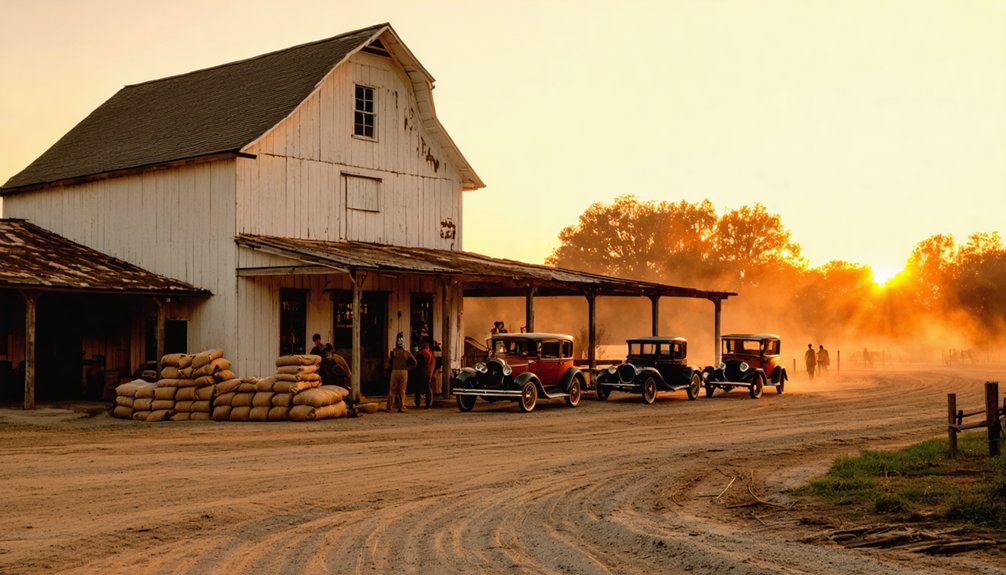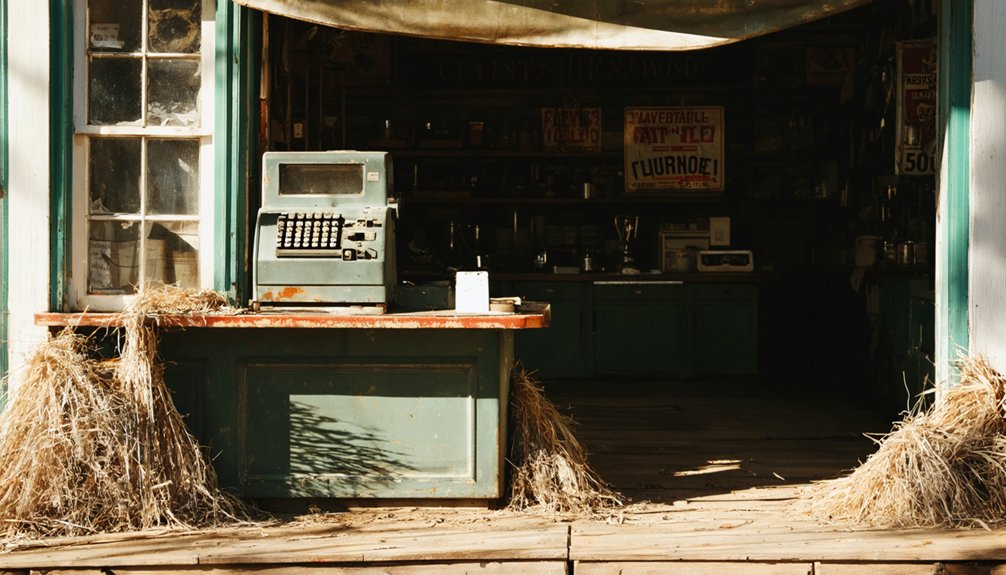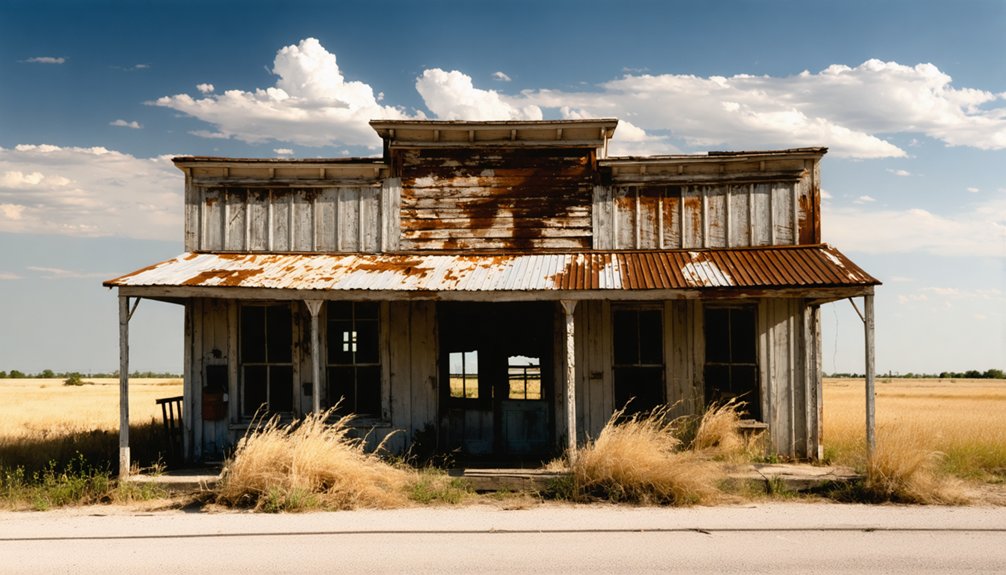You’ll find Neuse Store’s ghost town remains two miles northeast of New Braunfels in Comal County, Texas. Founded in 1847 by German immigrants Adam Neuse and Heinrich Wanschaff, this Hill Country settlement once buzzed with activity around its general store, cotton gin, and gristmill. A devastating fire in 1893 sparked its decline, and today, there’s little left of this former trading post. The story of its rise and fall reveals fascinating glimpses into early Texas frontier life.
Key Takeaways
- Neuse Store was established in 1847 by German immigrants Adam Neuse and Heinrich Wanschaff, located 2 miles northeast of New Braunfels, Texas.
- The settlement flourished as a commercial hub with a general store, cotton gin, and gristmill, reaching a population of 160 by 1885.
- A devastating fire in 1893 destroyed the business district and killed Dr. J.E. Rowbarts, marking the beginning of the town’s decline.
- The community’s abandonment was accelerated by population shifts to neighboring towns and the loss of influential community leaders.
- Today, no standing structures remain of the former German settlement, and the location sits on private property with restricted access.
Location and Geographic Features
Neuse Store stood just 2 miles northeast of New Braunfels in eastern Comal County, Texas, along what was once the bustling old Austin road.
You’ll find this ghost town nestled in the heart of Texas Hill Country, where limestone bedrock shapes the rolling terrain and influences the local vegetation patterns.
The area’s topographical features include gentle hills that rise above the surrounding floodplains, creating an ideal settlement spot near streams that feed into the Guadalupe River.
The environmental context reflects central Texas’s characteristic mix of dense oak-juniper woodlands and open grasslands.
If you’d visited during its heyday, you’d have experienced the region’s humid subtropical climate, with hot summers and mild winters that helped determine early settlers’ farming success.
The land’s elevation and proximity to water made it a natural choice for pioneers traveling westward.
Adam Neuse and Heinrich Wanschaff purchased fifty acres of prairie land here in 1847, establishing what would become the settlement.
Modern visitors can explore the area’s rich past through detailed maps of Comal County that showcase the historical landscape.
Historical Origins and Early Settlement
While German immigration to Texas was gaining momentum in the mid-1800s, two enterprising settlers named Adam Neuse and Heinrich Wanschaff laid the foundation for what would become Neuse Store. In 1847, they purchased fifty acres of prime prairie land within the Albert Survey in Comal County, joining the wave of German settlers seeking new opportunities in Central Texas.
You’ll find their story reflects the typical pattern of German immigration to the region – peaceful settlement, strong agricultural focus, and tight-knit community bonds.
These pioneers established homesteads and farmland, relying on mutual aid and shared cultural traditions to survive. Like many Texas settlements that faced the harsh realities of railroad bypasses, the community’s growth potential was limited by transportation challenges. Similar to how William Mingus arrived in 1856 to establish his own settlement in Palo Pinto County, they built their settlement from scratch, creating a self-sufficient settler community where German language and customs thrived.
Settlers forged tight bonds through shared German traditions, building a resourceful community where their cultural heritage flourished in the Texas frontier.
Though it never grew into a major population center, Neuse Store preserved its distinct German heritage throughout its early years.
The Rise and Fall of Commerce
You’ll find the story of Neuse Store‘s business life centered around its namesake general store, which served as a crucial trading post for German settlers and farmers in early Comal County.
The store’s importance as a commercial hub grew from its role meeting basic needs of the frontier community, exchanging goods and supporting the local agricultural economy. Like the famous Hicks-Cobb general store in Medicine Mound, it stood as a testament to frontier commerce. Texas communities like this were essential waypoints during the state’s westward expansion of the 1800s.
While the exact date isn’t recorded, the store’s eventual closure marked the end of Neuse Store’s role as a commercial center, leaving behind only remnants of its trading post past.
Trade Center Beginnings
Shortly after Cherokee County’s establishment in 1846, the area that would become Neuse Store began taking shape as an important trade hub.
You’ll find the true trade evolution began when Henry L. Reeves opened the first store in the early 1880s, transforming the settlement from a frontier outpost to a bustling commercial center.
By 1885, you’d have seen remarkable economic resilience as the population grew to 160, supporting essential businesses like a cotton gin, gristmill, and sawmill.
The community faced a devastating setback when a fire in 1893 destroyed nearly every building in town, though its resilient spirit led to quick reconstruction.
Much like Thurber’s company store that used mining scrip, local merchants maintained tight control over the area’s commerce.
What started as a humble trading post, nicknamed “Skin Tight,” quickly expanded into a diverse marketplace.
With the establishment of the Lone Star post office in 1883 and multiple mercantile stores by the late 1880s, you’d have witnessed the community’s transformation into a self-sufficient regional trade center.
Last Business Days
As rural populations dwindled throughout the late 20th century, the once-thriving Neuse Store faced mounting economic pressures that would ultimately seal its fate. The store’s final decline mirrored the town’s fall from its peak of 27 residents in 1896. Much like Longfellow Station, the town’s identity revolved entirely around its role as a rural commercial hub.
You’d have witnessed the final transactions taking place as nearby farms consolidated and locals moved away, leaving behind memories of daily customer experiences that had defined the store’s community role.
- The store’s last stand was marked by dusty windows revealing untouched merchandise behind the counter, while the remaining gas pump stood as a lonely sentinel to bygone days.
- You’d have noticed fewer cars pulling up as larger retail chains in neighboring towns drew customers away.
- Local cats roaming the property signaled the store’s shift from bustling trade center to quiet ghost town relic.
Notable Buildings and Landmarks
The remnants of Neuse Store offer limited glimpses into its frontier past, with few original structures remaining in this eastern Comal County ghost town.
If you’re exploring the area, you’ll find only scattered architectural remnants where Adam Neuse’s 1847 general store once stood. The site’s historical significance lies in its role as a crucial trading post along the old Austin road, just two miles northeast of New Braunfels.
While the original frontier-style buildings have largely disappeared over time, you can still appreciate the preserved surrounding landscape that once drew settlers to this location.
Though it’s not an officially designated historic site, local historians maintain interest in the area, and you might spot foundation stones or other subtle traces of this once-thriving community.
Life in Neuse Store’s Prime Years

You’ll find little concrete information about daily life during Neuse Store’s heyday, though it likely followed patterns common to rural Texas trading posts of its era.
If you’d visited during its prime years, you’d probably have seen farmers and ranchers gathering at the store to trade goods, swap stories, and catch up on local news.
The store would’ve served as more than just a place of commerce – it was probably the heart of local social life, where you could’ve found yourself joining fellow community members for impromptu meetings and friendly conversations.
Daily Trading Activities
During Neuse Store’s heyday, daily commerce buzzed with a steady stream of local farmers and ranchers who’d stop by to stock up on essential supplies.
You’d find the store’s shelves stocked with everything from flour and coffee to farming equipment, while barter practices kept goods moving even when cash was scarce.
- You could trade your crops, livestock, or even handmade goods for store credit or supplies you needed.
- During harvest season, you’d see peak trading activity as farmers settled their accounts and made larger purchases.
- If you needed to send mail, you’d handle that too since the store doubled as the local post office.
The store’s flexible payment system meant you could pay with cash, credit, or trade – whatever worked best for your situation.
Community Social Gatherings
Beyond the daily bustle of commerce, life in Neuse Store centered around rich social gatherings that kept the community’s spirit alive.
You’d find yourself drawn to the Methodist Church’s damaged belfry or the Baptist Church, where community traditions flourished through weekly services and social events. These weren’t just places of worship – they were the heartbeat of local decision-making and neighborly bonds.
Social networks thrived through seasonal celebrations, from harvest festivals to county fairs, where you could join in storytelling sessions, music performances, and barn dances.
You’d spend evenings enjoying radio programs with neighbors, sharing meals at community picnics, or participating in outdoor activities like fishing and hunting.
The churches, schoolhouse events, and agricultural celebrations wove together the fabric of Neuse Store’s vibrant rural life.
Rural Commerce Hub
Commerce bustled through Neuse Store’s streets in 1847 when Adam Neuse and Heinrich Wanschaff established this essential trading hub two miles northeast of New Braunfels.
You’d find yourself at the heart of rural trade along the old Austin road, where farmers and ranchers gathered to exchange their harvests and livestock.
If you’d visited during its prime, you’d have experienced these key economic interactions:
- Local settlers bartering crops and livestock at the trading post
- Merchants offering credit for essential supplies when cash was scarce
- Seasonal commerce flowing with the rhythms of planting and harvest
The general store stocked everything you’d need – from farming equipment to household goods.
Family-run businesses thrived here, creating a self-sufficient community where store owners lived on-site and kept commerce flowing day and night.
The Path to Abandonment

While Neuse Store initially thrived as a bustling rural community in the mid-1800s, its path toward abandonment began with a devastating fire in 1893 that destroyed nearly all of its business district. The catastrophic blaze, which originated in Dr. J.E. Rowbarts’ office and claimed his life, left only two buildings standing and devastated the town’s commercial heart.
You’ll find the abandonment reasons weren’t just tied to the fire – they cascaded from there. Without its key businesses and services, the town couldn’t maintain its appeal.
The population decline accelerated as residents sought opportunities elsewhere, especially in better-connected neighboring towns. The absence of strong transportation links and the death of influential figures like Henry L. Reeves left Neuse Store without the leadership needed to rebuild and reinvent itself.
Exploring the Ghost Town Today
Present-day visitors to Neuse Store will find little evidence of the once-thriving German settlement that stood here in the 1800s.
If you’re planning a ghost town exploration, you’ll need to venture about two miles northeast of New Braunfels into rural Comal County, where this slice of rural history has largely faded into the landscape.
- You’ll want to research property access before visiting, as the site may be on private land.
- Don’t expect any standing structures or visitor facilities – the original store building’s remains are undocumented.
- Pack your own supplies and be prepared for rough terrain, as there’s no infrastructure or marked paths.
The site’s remote location and minimal remains make it a challenging destination for amateur historians, but you’re free to explore if you can secure proper permissions.
Frequently Asked Questions
Were Any Movies or Television Shows Ever Filmed in Neuse Store?
You won’t find any film locations or ghost stories captured on camera here – there’s no evidence of movies or TV shows ever being filmed in this forgotten spot.
What Happened to the Families Who Originally Lived in Neuse Store?
You’ll find most families scattered to nearby Texas towns seeking better opportunities, though their family legacy lives on through historical records and community impact in Comal County’s German-Texan heritage.
Are There Any Documented Paranormal Activities Reported at Neuse Store?
While over 250 Texas ghost towns report paranormal activity, you won’t find documented ghost sightings or paranormal investigations specifically at Neuse Store – though local folklore hints at unexplained occurrences typical of abandoned settlements.
Did Any Notable Historical Figures Ever Visit Neuse Store?
You won’t find any records of famous visitors to this spot – there’s no historical significance tied to notable figures. It was a humble German trading post without documented celebrity encounters.
What Native Artifacts Have Been Discovered in the Neuse Store Area?
You’ll find stone darts, boomerangs, and spear-throwing tools dating back 7,000 years, plus pottery with unique designs. Native tools and archaeological findings also include bifaces and incised stones from ancient workshops.
References
- https://www.mysanantonio.com/news/local/article/Texas-ghost-town-featured-in-new-documentary-5623452.php
- https://www.hipcamp.com/journal/camping/texas-ghost-towns/
- https://www.youtube.com/watch?v=PsuLwAQ12QI
- https://texashighways.com/travel-news/four-texas-ghost-towns/
- https://www.youtube.com/watch?v=phjUE19A8HM
- https://en.wikipedia.org/wiki/List_of_ghost_towns_in_Texas
- https://en.wikipedia.org/wiki/Neuse_Store
- https://discovertexasoutdoors.com/places/neuse-store-texas-early-german-settlement-and-historic-ghost-town-in-comal-county/
- https://www.tshaonline.org/handbook/entries/neuse-store-tx
- https://www.youtube.com/watch?v=Ux4FjzHs5DE



